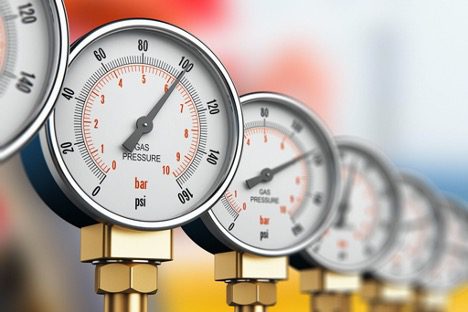
On high-vibration industrial applications, reading a pressure gauge is often frustrating–and in some cases, downright impossible without the proper configuration on the gauge. An indicating needle that rapidly shakes back and forth makes it difficult to get an actual reading–especially so if the needle falls off its access because of the vibration. Damage to the needle and/or the gauge is another source of frustration, as are inaccurate readings due to the constant wear and tear experienced by the pressure gauge’s internal components.
Contact us today to discuss your high-vibration application
How does a Pressure Gauge Work?
Before getting into the difficulties associated with high-vibration pressure gauges and how to overcome them to gain accurate readings, it’s important to know how a pressure gauge works. For this, we’ll turn to the most commonly used type of pressure gauge: the Bourdon tube pressure gauge. This is a hollow, c-shaped spring element within the case. As the tube is pressurized by the substance entering it, it starts to move–similar to an inflating balloon that wiggles around as the air inside it equalizes. This movement is translated through a connecting link that’s attached to the Bourdon tube via an end piece, resulting in a pressure measurement that is indicated by the pointer indicates on the gauge’s dial.
The Difficulties Involved with Reading Pressure Gauges on High-Vibration Applications, and the Requisite Solutions
Difficulties
Numerous studies have shown that vibration is the main cause of failure for pressure gauge applications in manufacturing facilities. Vibration’s negative impact on gauge accuracy is evidenced in two ways. Firstly, it is difficult to read the pointer on a dial when a gauge is vibrating. And second, incremental damage to the pointer mechanism from vibration can eventually move a pointer off zero, producing inaccurate readings.
Visible signs of mechanical vibration include metal filings and dust inside the gauge window that form a kind of halo around the window’s perimeter. This material is the product of worn pinion and segment gears. Moreover, if the vibration has been high enough/severe enough, the pointer itself might be detached or noticeably loose. Risks posed by mechanical vibration include loss of accuracy/functionality and pressure system failure.
Solutions
For most situations, a liquid-filled case is the most convenient, cost-effective way to protect pressure gauges in the Midwest from vibration and get accurate readings in high-vibration applications. The liquid, which is typically glycerin or silicone oil, acts as a damper to slow down the movement. It also lubricates the pinion and segment gears, thereby reducing wear and prolonging the life of the gauge. Another solution is to move the gauge away from the source of the vibration. This can be done by using a diaphragm seal with a capillary connection, for example, a 990.28 cell-type (sandwich) seal. A diaphragm seal can be mounted practically anywhere in the application, and the line allows for remote reading.
A third solution to consider is a socket restrictor. This small device has a tiny orifice that helps restrict and slow down the pressure of the media before it encounters the gauge. Restrictors are cost-effective and easy to install–and in fact, several gauges come standard with a restrictor already threaded into the bore.
Midwest Instrument offers liquid-filled cases, typically using glycerin or silicon filling to dampen pointer bounce in vibration applications. Vibration dampening in differential pressure gauges can be found in our most popular models such as Model 120, Model 140 and Model 142.

